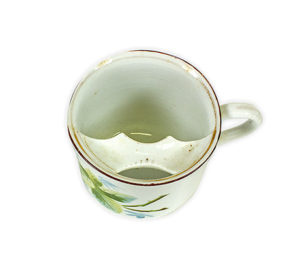Need help to know how to post your response. Check FAQ page.
23
Oct 19Epiphanies
I’m in the store rooms of the Jewish Museum in London, and the collections manager shows me and a few other volunteers a cup just like this one.
“Can you guess why the top is shaped like that?” she asks. Nobody knows the answer.
The collections manager transports us back to a time of moustached men in posh clothes drinking tea — OH! Of course, that makes sense now, it’s to keep their moustache dry!
A few months later, I’m at the Institute of Making at University College London to look at their collection of materials, from gold-plated spoons to aerogel.
The curator shows me this hard blob of melted greenish plastic. “This is a by-product of the recycling process” she says, “Plastic bottles arrive to the factory, they are shredded into small bits, and dyed plastic is separated from non-dyed plastic using a colour separating machine. At the end of the melting process, waste material is extruded and this stuff spills out on the factory floor.”
So what? I think to myself. The gold-plated spoons looked way more interesting.
“Now, considering that most of the dyed plastic comes from milk bottles, can you guess what this blob tells us about milk consumption in Britain?”
Uhm, I’m sorry, have I missed a step here? How is a blob of melted plastic supposed to tell me about milk consumption in the UK?
“The colour separator is not 100% accurate” she says, “Sometimes dyed plastic goes through and stains what’s supposed to be white plastic”.
I picture the fresh milk aisle in UK supermarkets. Skimmed milk, white bottle, red cap. Whole milk, white bottle, blue cap. Semi-skimmed milk, white bottle, green cap!
“Recycled plastic eventually turns green because most people buy semi-skimmed milk at the supermarket — now they put less dye in the plastic to reduce this ‘greening’ effect” she concludes.
I am in awe — from a green blob of plastic to milk consumption in the UK. An object so understated, yet representative of much larger realities. Whenever I visit museums, I long for these epiphanies. These moments when an object just makes you go “Aha!”.
